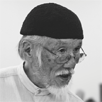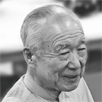
Kenji Ekuan
The most difficult part of the Final Assessment this time is selecting
the Advanced Design Prize winner. The prize is for promoting product
development. I was startled to come across the term “product” because
I had never considered Urushi ware as products.
Japanese people have had trouble in considering elegant and noblelady-
like Urushi ware as products perhaps because they have worked
hard to manufacture industrial products and sell them to foreign countries
for many years since the end of World War II. I wonder if they
have pursued the so-called virginity in Urushi ware among numerous
other arts and crafts items.
It is true that Urushi ware producing regions will be declining unless
they make Urushi products which the consumers would like to buy.
For me, however, making artistic items into products is as if losing
their virginity. I was in a fix. Luckily this prize winner is an item which
makes me realize the new type of virginity of Urushi. If someone asks
me if the item can be a product on the market, I cannot answer “Yes”,
but it truly has novelty. For me the value of some products means novelty
itself. This item has the harmony between the fabric and Urushi.
It broadens your soul. You have not had such a thing before. The
producer has deepened the origin of Urushi. Then you can discover
something like a noble lady. In Japan Urushi has been the basic of
daily utensils, while in Europe they have used Urushi as materials for
creating objects in various bold ways. It surprised me. They consider
Urushi as one of the pigments, which does not agree with me, though.
It is, however, stimulating for me that they use Urushi freely in Europe
without any conventional frameworks. Urushi in Japan meets with
Urushi in the West. It is truly a goal of the international competition.

Nagatoshi Ohnishi
I have hoped that this exhibition should provide opportunity to focus
on the future feature and new possibility of Urushi from the global
perspective. This time I felt that my dream has nearly come true.
Fortunately such good examples received awards. The Grand Prize
winner “Stone Implement Bowl” by Takeshi Igawa is a sharp and
straight item with its perfect form and skillful coating. I really admire
his attitude to pursue the beauty of black Usushi which is the basic
of Urushi. The Gold Prize winner “female – a bathtub or bed for baby
– “, a Kanshitsu item, has an organic and gentle form and its vermillion
Urushi is perfect for celebrating the birth of life. The silver Prize
winner “Dream” by Young Sun Ra (Korea ) is a reticent vessel.
I was deeply impressed to hear Dr Kopplin expressing herself on this
work “quiet and strong”.
The artist knit the yarn and made the form and applied Urushi to
harden it. It is extremely durable. Something authentic never dies
out. One of the Honorable Mention winners “RELIGLO – RE –
BOUND TO THE SOURCE” by Manfred Schmid (Germany) harbors
spirituality and it keeps power to touch your original emotion.
The artist does not show off his skills and the vessel expresses
something innocent.
On the Advanced Design Prize winner “Urushi clothes” by Mikio Shina,
all the jury members exchanged active and sometimes heated
discussion. The fabric has something quiet and unique.
I hope that this product will be improved and sold on the market.
First you must solve the problem of the coarse texture of the fabric
and Urushi. Koshu Inden has been one of the successful examples
of such improvement in Japan.

Ryoichi Komatsu
The Ishikawa International Urushi Exhibition which started
in 1989 for promoting understanding of the charm of Urushi
throughout the world has celebrated its 8th exhibition in
2009.
This time the new prize The Advanced Design Prize, was
established for stimulating product development as well as
the utilization of the local technology. After the active discussion
among the jury members this prize winner was finally
selected.
The Grand Prize winner “Stone Implement Bowl” is a trayshaped
object with the image of a sharply cut stone piece.
It expresses spiritual time and space with deep black Urushi
and the luster of the surface. This work is highly accomplished.
The Gold Prize winner “Baby Bath” holds gently curving
form coated with vermilion Urushi, which reminds you of the
baby’s soft skin. It is one of the pleasant proposals for our
lifestyle. It also introduces you the efficacy of Urushi.
The Advanced Design Prize winner is a Urushi applied jacket
which needs some improvement so that the texture of the
fabric can be more comfortable for the body.
Urushi has drawn the public attention as an eco-friendly material.
It harbors particular beauty and power, as well. How
are you going to grasp the true value of Urushi? I look forward
to the answers to this question at the next competition.

Kwon Sang-Oh
It is a distinct honor to be invited as a jury member of the
Final Assessment Panel for the Ishikawa International Urushi
Exhibition 2009 following the previous exhibition.
We found many items which express new proposals of lifestyle,
function development and new sensibility.
This time more contemporary works were applied than those
of the previous exhibition. As a whole, design has become
more sophisticated but I am sorry that the two dimensional
works are not so excellent than three dimensional items.
All the jury members agreed to give the Grand Prize to the
simple, black work. It holds both function and beauty. Its
simple form and the artist’s Urushi coating techniques are
truly admirable.
The Advanced Design Prize winner is a good example of a
new proposal for product development. The item still needs
some improvement; when the cloth or fabric is applied with
Urushi, you can soften it with some chemical treatment.
I hope the exhibition will help promote international exchanges
in Urushi and activate Urushi related industries, so that
the value of Urushi will be admired in your daily life.

Fumio Mae
The field of arts and crafts has produced functional utensils as well
as better, more beautiful and more sophisticated items for ages.
Those items have reflected the lifestyle of the people of each era.
I have created my art works in the field of Japanese traditional arts
and crafts where we have tried to preserve and improve conventional
craft techniques.
In short, I have created the item with both function and beauty. For
the second time I participated in the Final Assessment by holding
my own philosophy of creation. The applied works from home and
abroad to this competition vary from truly artistic items to the items
close to the utensils for our everyday life. I have been impressed
with the broad range of their forms, designs and decorations.
The Grand Prize winner “Stone Implement Bowl” is an excellent
work with a sharp form coated with black Urushi. It has an image
of a sharply cut piece of a stone.
The Gold Prize winner “female ~a bathtub or bed for baby~” expresses
something heartwarming and some story like a fairy tale.
I am impressed with its gentle shape and the beauty of vermilion
Urushi. Urushi has power to kill germs, we have believed for a long
time.
The newly established prize “The Advanced Design Prize” targets
product development. It is very difficult to distinguish art works
from market products, but the prize winner is a good example of
new fabric development and Urushi application. It maintains texture
and beauty of Urushi.
I have assessed all the works with great care and interest.

Monika Kopplin
My first participation in the Final Assessment at the International Urushi Exhibition
was not only enriching and inspiring, it also made me aware of this event’s signifi-
cance for contemporary lacquer art. Those responsible in the Ishikawa Prefecture
deserve great respect for their efforts in securing a future for lacquer work.
Though Japanese and Korean entrants predominate, submissions from ten other
nations and regions demonstrate that lacquer is standing its ground as a material
for international craftwork and design. Most candidates work with Urushi or Rhus
lacquer from East or South-East Asian sources. France, pioneer of an independent
European lacquer art breaking away from East Asian models in the 18th century,
is the only country where some artists still use oil-based lacquers to produce
innovative and surprising artistic creations. The continuation of this tradition,
which has been lost in all other western countries, seems particularly important
to me as a European. Only two artists still work with lacquer in Germany, where
outstanding baroque lacquer workshops were distinguished by their cultural empathy
with East-Asian aesthetics. These two employ Urushi and in turn manifest
their debt to Japanese lacquer in style and technique.
The wide variety of exhibited artworks includes traditional techniques and functions,
as well as startlingly experimental and sometimes playful pieces. Some
works, including the one by Igawa Takeshi which was awarded the grand prize,
possess a spiritual quality. The gold and silver prize-winners combine a traditional
function – a tub for bathing a newborn baby and a washbasin – with clear, timeless
design that highlights the lacquer’s inherently tranquil beauty. The not yet
fully matured but promising impregnation of fabrics with Urushi, and some very
idiosyncratic sculptures, indicate the technological and artistic potential of contemporary
lacquer.

Shinichi Yamamura
Some 200 applied works at the Ishikawa International Urushi
Exhibition 2009 vary from tiny jewelries which can be hold
on your palm to a large scale monument which is as large as
the size limit.
The Preliminary and Final Assessments were conducted and
after the heated discussion The Grand Prize, Gold Prize, Silver
Prizes, Honorary Mentions, and Jurors’ Special Prizes as
well as the Advanced Design Prize winners were selected.
Urushi is called “japan” and it represents Japanese traditional
arts and crafts. Further more, in Ishikawa are major Urushi
ware producing regions, Wajima and Yamanaka. So holding
this international Urushi competition in Kanazawa, Ishikawa
is truly significant.
Today, however, the situation of each traditional arts and
crafts producing region in Japan has faced difficulties in
continuing their businesses. So establishing the new prize
for promoting product development can be considered as
the organizer’s strong message to support Urushi industries
throughout the world.
I hope that this exhibition will help activate Urushi ware producing
regions in Ishikawa as well as in Japan.

Toyojiro Hida
I participated only in the Preliminary Assessment based on
slides. So I cannot talk about the real works. While looking at
the trends of the applied works, I got the impression that the
applicants had been startled. I wonder if the applicants could
understand what kind of artworks or products this exhibition
has asked for. I am afraid that they have not yet grasped this
particular point. I found several categories of items at the
Assessment; traditional arts and crafts, objects, industrial
products, crafts, and daily utensils.
The quality of each applied work is quite high, but I am sorry
to say that none of them has pursued its extreme best. Many
of them hold compromise of various trends. If you would like
to enjoy traditional Urushi ware, you would rather visit the
Japan Traditional Arts and Crafts Exhibition.
Those who are judged are not the applicants but the organizer
of this Ishikawa International Urushi Exhibition, are they?
The applicants have tried applying their multi trend items
and tried to understand the purpose of the organizer.
The organizer established the new prize, the Advanced
Design Prize to make the purpose of the exhibition clearer.
Further more they should clearly explain the direction of
this exhibition to the applicants and to the people who have
supported this exhibition. I would like to express my selfreproach
as well.
事務局
国際漆展・石川開催委員会事務局
〒920-8203 金沢市鞍月2丁目20番地
石川県地場産業振興センター新館4階 (財)石川県デザインセンター内
TEL(076)267-0365 FAX(076)267-5242
http://www.design-ishikawa.jp/
Secretariat
The Secretariat Office of the Executive Committee
The Ishikawa International Urushi Exhibition
c/o Design Center Ishikawa
2-20 Kuratsuki, Kanazawa, Ishikawa 920-8203 JAPAN
Tel: +81-76-267-0365 Fax: +81-76-267-5242
